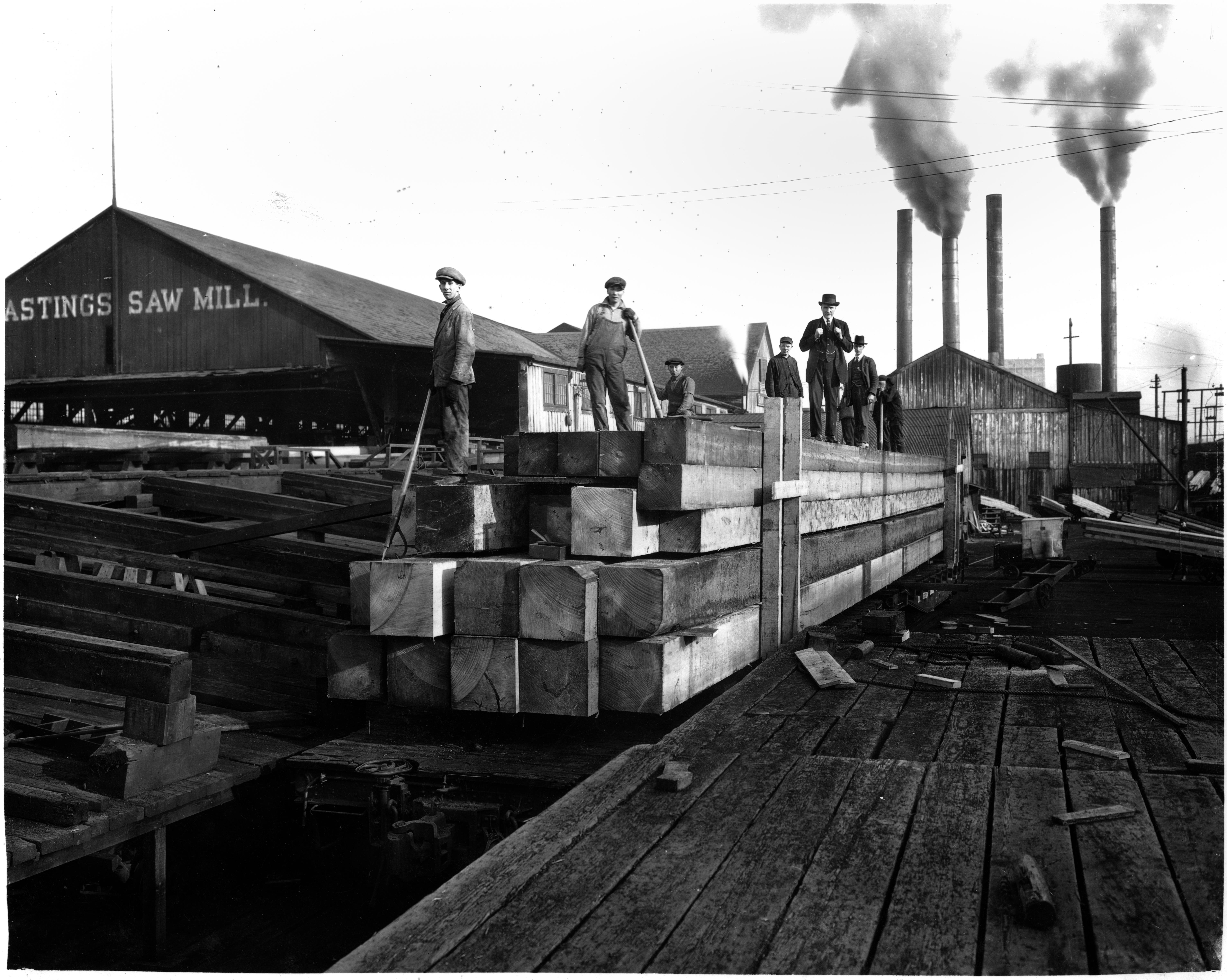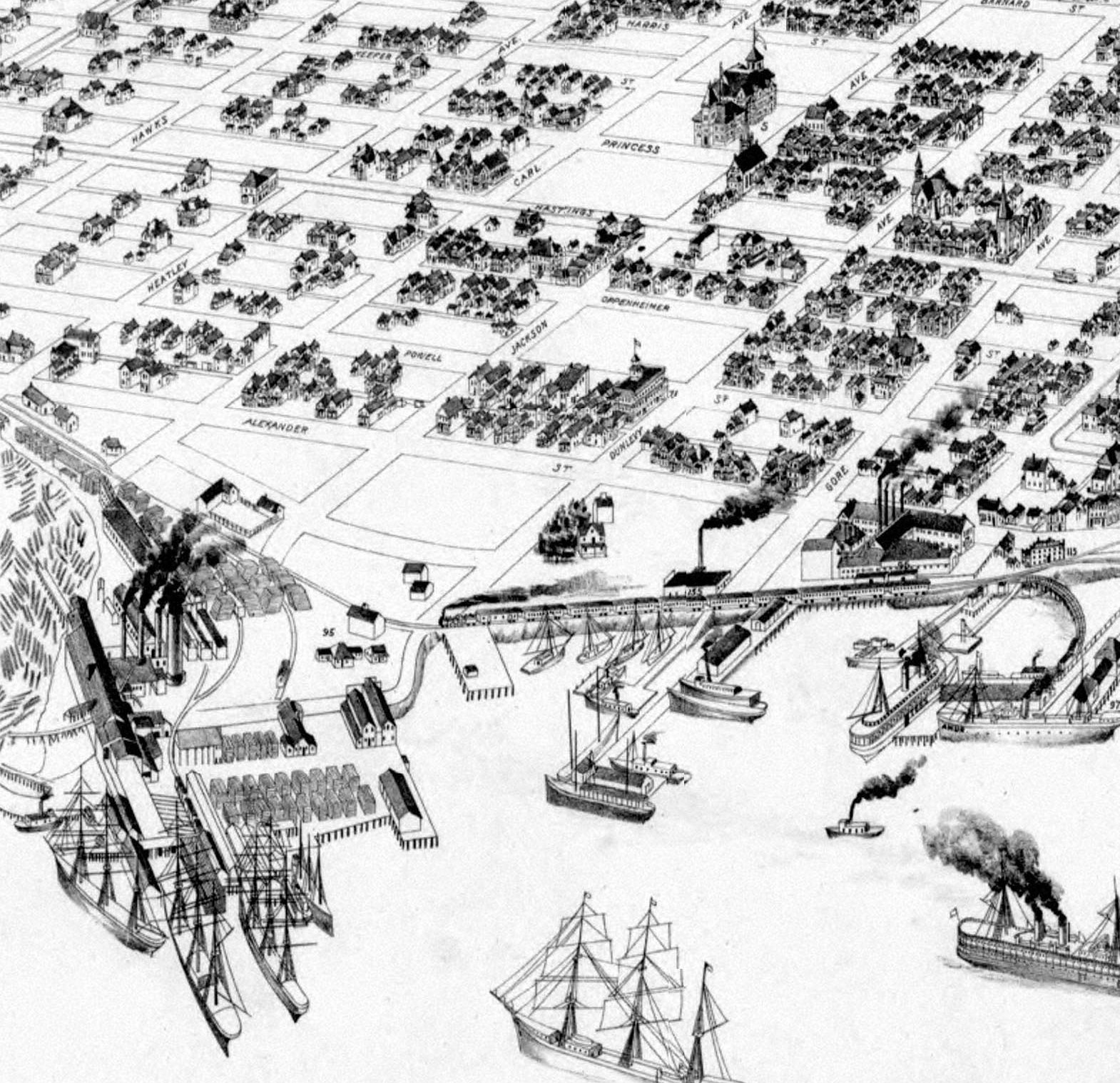Hastings Mill on:
[Wikipedia]
[Google]
[Amazon]
 Hastings Mill was a
Hastings Mill was a

"The Old Hastings Mill Store Museum,"
''Walking tours of Vancouver with John Atkin'' website.
 Hastings Mill was a
Hastings Mill was a sawmill
A sawmill (saw mill, saw-mill) or lumber mill is a facility where logging, logs are cut into lumber. Modern sawmills use a motorized saw to cut logs lengthwise to make long pieces, and crosswise to length depending on standard or custom sizes ...
on the south shore of Burrard Inlet
french: Baie Burrard
, image = Burrard Inlet 201807.jpg
, image_size = 250px
, alt =
, caption = Aerial view of Burrard Inlet
, image_bathymetry = Burrard-Inlet-map-en.svg
, alt_bathymetry ...
and was the first commercial operation around which the settlement that would become Vancouver
Vancouver ( ) is a major city in western Canada, located in the Lower Mainland region of British Columbia. As the most populous city in the province, the 2021 Canadian census recorded 662,248 people in the city, up from 631,486 in 2016. ...
developed in British Columbia
British Columbia (commonly abbreviated as BC) is the westernmost province of Canada, situated between the Pacific Ocean and the Rocky Mountains. It has a diverse geography, with rugged landscapes that include rocky coastlines, sandy beaches, for ...
, Canada
Canada is a country in North America. Its ten provinces and three territories extend from the Atlantic Ocean to the Pacific Ocean and northward into the Arctic Ocean, covering over , making it the world's second-largest country by to ...
. Founded in 1865 by Edward Stamp
Captain Edward Stamp (5 November 1814 – 20 January 1876) was an English mariner and entrepreneur who contributed to the early economic development of British Columbia and Vancouver Island.Lamb, W. K. (2000). Stamp, Edward. ''Dictionary of Cana ...
, the sawmill operated until its closure in 1928.
The store building of Hastings Mills was moved to Alma Street in 1930, situated within present day Hastings Mill Park. The store building was opened as the Old Hastings Mill Store Museum in 1932, and houses exhibits that showcase artifacts and items of significance to Vancouver's history.
History
In 1867,Captain Edward Stamp
Captain Edward Stamp (5 November 1814 – 20 January 1876) was an English mariner and entrepreneur who contributed to the early economic development of British Columbia and Vancouver Island.Lamb, W. K. (2000). Stamp, Edward. ''Dictionary of Can ...
began producing lumber in Stamp's Mill at the foot of what is now Dunlevy Avenue after a planned site at Brockton Point
Brockton Point is a headland off the Downtown Peninsula of Vancouver, on the north side of Coal Harbour. Named after Francis Brockton, it is the most easterly part of Stanley Park and is home to a 100-year-old lighthouse and several hand-carve ...
proved unsuitable due to difficult currents and a shoal. Stamp's efforts in developing the mill are summarized by Robert Macdonald in ''Making Vancouver: Class, Status and Social Boundaries, 1863-1913'':

In 1865 he formed a company in England, backed by capital of $100,000 , to produce lumber in British Columbia. Stamp also secured from the colonial government of British Columbia the right to purchase or lease of timber on the lower coast, and selected a mill site on a point of land along Burrard Inlet's south shore. Delayed by the failure of crucial machinery parts to arrive from England, Stamp did not begin cutting lumber for export until June 1867. After managing the firm for less than two years he retired, and shortly thereafter his company went into liquidation in England. The mill closed for a period in 1870 but opened again in August after being purchased by Dickson, DeWolf and Company of San Francisco. Known at first as Stamp's Mill, it now became the Hastings Sawmill Company, or Hastings Mill.The early settlement was in effect a company town. People shopped at the Hastings Mill Store and sent their children to the Hastings Mill School, which included students from Moodyville on the opposite side of the inlet. This would change after the
Canadian Pacific Railway
The Canadian Pacific Railway (french: Chemin de fer Canadien Pacifique) , also known simply as CPR or Canadian Pacific and formerly as CP Rail (1968–1996), is a Canadian Class I railway incorporated in 1881. The railway is owned by Canad ...
chose Vancouver as the terminus for the transcontinental railway. Nevertheless, the lumber industry remained the backbone of the new settlement's economy, and Hastings Mill was "the nucleus around which the city of Vancouver grew up in the 1880s" and remained important to the local economy until it closed in 1928.
Museum
After Hastings Mill closed, the building that housed the Hastings Mill store was transported by barge to the foot of Alma Street in 1930. The building was officially reopened in 1931, and was dedicated as the Museum of B.C. Historical Relics in Memory of the Pioneers, or the Old Hastings Mill Store Museum in 1932. Operated by the Native Daughters of British Columbia, the museum houses artifacts and curiosities from Vancouver's past, andFirst Nations
First Nations or first peoples may refer to:
* Indigenous peoples, for ethnic groups who are the earliest known inhabitants of an area.
Indigenous groups
*First Nations is commonly used to describe some Indigenous groups including:
**First Natio ...
art.
Built in 1865, the museum building is the oldest building in Vancouver. The building was one of the only structures to survive the Great Vancouver Fire in 1886, and was used as a hospital and morgue for the fire's victims.''Walking tours of Vancouver with John Atkin'' website.
See also
*John Hendry (industrialist)
John Hendry, (January 20, 1843 - July 17, 1916), created B. C. Mills, the first major lumber company in western Canada starting with his first mill in 1875. He is a person of National Historic Significance in Canada.
Early life
Hendry was bo ...
* List of heritage buildings in Vancouver
* List of museums in British Columbia
References
External links
* {{official, http://www.hastingsmillmuseum.ca/ Museums in Vancouver History museums in British Columbia Manufacturing companies based in Vancouver Canadian companies established in 1867 History of British Columbia Defunct companies of British Columbia History of Vancouver Heritage buildings in Vancouver Manufacturing companies established in 1867